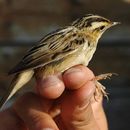Biology
provided by Arkive
The aquatic warbler is more secretive than its common relative, the sedge warbler, and often remains hidden on the ground whilst actively searching for food. Similar to the other warblers, the aquatic warbler feeds primarily on small insects (3).
During the breeding season, males attract mates with a song produced during a short song-flight. A single male will normally mate with more than one female; mating amongst birds is usually a very brief affair, but for the aquatic warbler however, it can last around 25 minutes, taking place both before and after egg-laying. Nests are constructed from reeds and tend to be placed over marshy ground or in a clump of sedge in shallow water (4).
Conservation
provided by Arkive
The aquatic warbler is a UK Biodiversity Action Plan species, and a number of known key passage sites have been designated as Sites of Special Scientific Interest (SSSIs) (5). Key sites are being managed by organisations such as the RSPB in order to maintain suitable habitat of sufficient size to support migration. A further priority is to more accurately assess the number of birds passing through Britain and their ecological requirements so that the correct habitat can be identified as being in need of protection (3).
Description
provided by Arkive
The aquatic warbler is a small, slim bird with sandy coloured plumage with variable fine black streaking. Further identifying features are a sandy coloured crown and a rather spiky looking tail. The sexes are similar, and juveniles lack streaking on the breast and flanks (2). The eggs of the aquatic warbler are brown and densely spotted with a yellowish grey (4).
Habitat
provided by Arkive
The aquatic warbler breeds in open waterlogged areas of sedge, and seems to prefer vegetation of just a foot tall (2). During migration, preferred habitat comprises reed beds with sedge and other low-lying vegetation close to open water, normally along rivers, estuaries and coastal lagoons (3).
Range
provided by Arkive
The aquatic warbler passes through the southern coast area of England during its annual migration between breeding sites in Eastern Europe and over-wintering grounds in West Africa. Although no definite figures exist, it was believed that the number of individuals arriving in Britain could represent as much as 25% of the world population of this globally threatened species, but recent discoveries of large populations in Eastern Europe make this unlikely (3). The main stronghold is in eastern Poland (2).
Status
provided by Arkive
Listed on the Red List of Birds of Conservation Concern. Protected under the Wildlife and Countryside Act 1981, Annex I of the EC Birds Directive and Appendix II of the Berne Convention (3).
Threats
provided by Arkive
For a healthy population, this species requires vast areas of wetland habitat. This is due to the large home ranges that males of this species occupy during the breeding season in order to gain access to several females. Such habitat is increasingly under threat from modern agricultural practices and is often drained for commercial use. Other threats may occur on the wintering grounds. The human population increase in West Africa is putting pressure on the habitat needed by this species such as over-grazing, over-exploitation of water resources and desertification (3).

